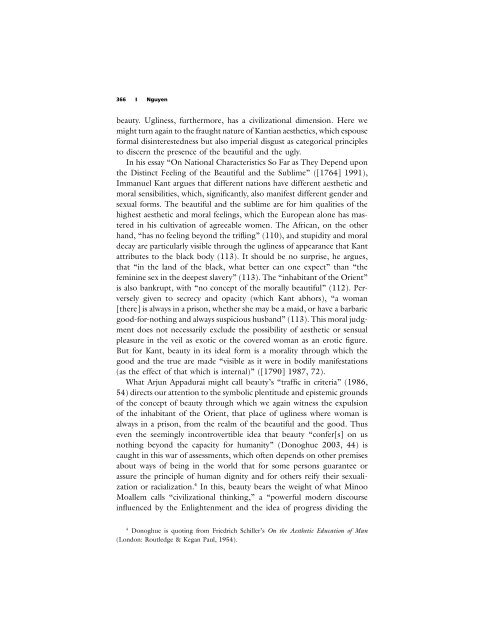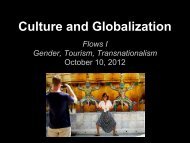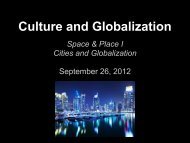Mimi Thi Nguyen, “The Biopower of Beauty: Humanitarian
Mimi Thi Nguyen, “The Biopower of Beauty: Humanitarian
Mimi Thi Nguyen, “The Biopower of Beauty: Humanitarian
Create successful ePaper yourself
Turn your PDF publications into a flip-book with our unique Google optimized e-Paper software.
366 ❙ <strong>Nguyen</strong><br />
beauty. Ugliness, furthermore, has a civilizational dimension. Here we<br />
might turn again to the fraught nature <strong>of</strong> Kantian aesthetics, which espouse<br />
formal disinterestedness but also imperial disgust as categorical principles<br />
to discern the presence <strong>of</strong> the beautiful and the ugly.<br />
In his essay “On National Characteristics So Far as They Depend upon<br />
the Distinct Feeling <strong>of</strong> the Beautiful and the Sublime” ([1764] 1991),<br />
Immanuel Kant argues that different nations have different aesthetic and<br />
moral sensibilities, which, significantly, also manifest different gender and<br />
sexual forms. The beautiful and the sublime are for him qualities <strong>of</strong> the<br />
highest aesthetic and moral feelings, which the European alone has mastered<br />
in his cultivation <strong>of</strong> agreeable women. The African, on the other<br />
hand, “has no feeling beyond the trifling” (110), and stupidity and moral<br />
decay are particularly visible through the ugliness <strong>of</strong> appearance that Kant<br />
attributes to the black body (113). It should be no surprise, he argues,<br />
that “in the land <strong>of</strong> the black, what better can one expect” than “the<br />
feminine sex in the deepest slavery” (113). The “inhabitant <strong>of</strong> the Orient”<br />
is also bankrupt, with “no concept <strong>of</strong> the morally beautiful” (112). Perversely<br />
given to secrecy and opacity (which Kant abhors), “a woman<br />
[there] is always in a prison, whether she may be a maid, or have a barbaric<br />
good-for-nothing and always suspicious husband” (113). <strong>Thi</strong>s moral judgment<br />
does not necessarily exclude the possibility <strong>of</strong> aesthetic or sensual<br />
pleasure in the veil as exotic or the covered woman as an erotic figure.<br />
But for Kant, beauty in its ideal form is a morality through which the<br />
good and the true are made “visible as it were in bodily manifestations<br />
(as the effect <strong>of</strong> that which is internal)” ([1790] 1987, 72).<br />
What Arjun Appadurai might call beauty’s “traffic in criteria” (1986,<br />
54) directs our attention to the symbolic plentitude and epistemic grounds<br />
<strong>of</strong> the concept <strong>of</strong> beauty through which we again witness the expulsion<br />
<strong>of</strong> the inhabitant <strong>of</strong> the Orient, that place <strong>of</strong> ugliness where woman is<br />
always in a prison, from the realm <strong>of</strong> the beautiful and the good. Thus<br />
even the seemingly incontrovertible idea that beauty “confer[s] on us<br />
nothing beyond the capacity for humanity” (Donoghue 2003, 44) is<br />
caught in this war <strong>of</strong> assessments, which <strong>of</strong>ten depends on other premises<br />
about ways <strong>of</strong> being in the world that for some persons guarantee or<br />
assure the principle <strong>of</strong> human dignity and for others reify their sexualization<br />
or racialization. 4 In this, beauty bears the weight <strong>of</strong> what Minoo<br />
Moallem calls “civilizational thinking,” a “powerful modern discourse<br />
influenced by the Enlightenment and the idea <strong>of</strong> progress dividing the<br />
4 Donoghue is quoting from Friedrich Schiller’s On the Aesthetic Education <strong>of</strong> Man<br />
(London: Routledge & Kegan Paul, 1954).





